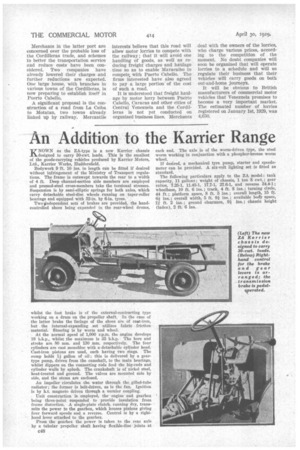TRADE ROUTES CHANGED
Page 77

Page 78

If you've noticed an error in this article please click here to report it so we can fix it.
by the
MOTOR LORRY.
T TNTIL a short time ago the City of Maracaibo was the great entrep6t of Western Venezuela. It stands at the entrance of the gulf of the same name, which, owing to the presence of a bar, is closed to ocean-going vessels with a draught of more than 12 ft. All goods imported into or exported from this region must, therefore, be transhipped at Maracaibo. Smaller steamers ply between the city and the gulf ports, but goods have again to be put on to short railway lines leading into the interior, primary collection or final delivery being effected by mule train or motor lorry.
As might be imagined, this multi
plicity of handling haS meant that transport costs were high and the risk Of damage great. Then came the opening of •the Transandine Highway, and the planters and merchants of Western Venezuela saw an opportunity for getting their goods from Puerto Cabello or from Caracas. This new trade route enabled them to obtain their merchandise in a much shorter time than if they had sent their orders to Maracaibo; very often, too, at a cheaper rate.
The Government of Venezuela built this road to connect Caracas, the capital, with the western states. It passes over the Cordilleras and through the important cities of Mstracay, Valencia, San Carlos, Barquisimeto, Trujillo, Valera, Merida and San Cristobal. It then passes across the Colombian frontier to Cucuta, and will ' ultimately reach Bogota, the capital of that country. This road is kept in good condition by the Government, and for its entire length of about 1,000 miles it can be used by motor lorries. Such vehicles are,now delivering goods landed at ,Caracas or Puerto Cabello to merchants in Trujillo, Valera, Merida and San Cristobal, as well as to merchants in places which are connected by good roads with these towns.
Without doubt the merchants of the Cordilleras are in a much better position than they were
before the construction of the Transandine Highway. They can now wire to Puerto Cabello for a consignment of goods and secure delivery within four days. On the other hand, goods received from Maracaibo take from 8 to 14 days to reach their destination. Moreover, these merchants pay, on tho whole, , about the same freight charges from bath ports, whilst the ocean freight is nearly a less per ton to Puerto Cabello than it is to Maracaibo. Merchants in the latter port are concerned over the probable loss of the Cordilleras trade, and schemes to better the transportation service and reduce costs have been considered. Two companies have already lowered their charges and further reductions are expected. One large house, with branches in various towns of the Cordilleras, is now preparing to establish itself in Puerto Cabello.
A. significant proposal is the construction of a road from La Ceiba to Motatan, two towns already linked up by railway. Mercantile interests believe that this road will allow motor lorries to compete with the railway ; that it will avoid one handling of goods, as well as reducing freight charges and haulage time so as to enable Maracaibo to compete, with Puerto Cabello. The firms interested. have also agreed to pay a large portion of the cost of such a road.
It is understood that freight haulage by motor lorry between Puerto Cabello, Caracas and other cities of Central Venezuela and the Cordilleras is not yet conducted on organized business lines. Merchants deal with the owners of the lorries, who charge various prices, according to the competition of the moment. No doubt companies will soon be organized that will operate lorries to a schedule and will so regulate their business that their vehicles will carry goods on both out-and-home journeys.
It will be obvious to British manufacturers of commercial motor vehicles that Venezuela promises to become a very important market. The estimated number of lorries registered on January 1st, 1929, was 4,650.




























































































































